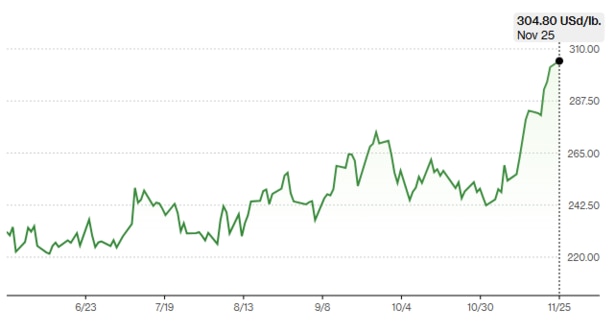Why the cost of your daily coffee is set to skyrocket
Cafe-goers are set to be hit with further price hikes on their daily coffees, but what’s the cause?
Retail
Don't miss out on the headlines from Retail. Followed categories will be added to My News.
Coffee-drinkers should brace for a further hike in the price of their morning brew.
Adverse weather conditions and continued supply chain disruptions for some of the globe’s biggest suppliers has seen bean prices continue to rally. Arabica bean futures, which in essence are an agreed upon price for the future delivery of the beans, this week hit its highest price on a closing basis since March 1977, at $US3.05 per pound ($A4.69 per 453g).
Coffee has been one of the top performing commodities of the year, with Arabica beans – which produce the majority of Australia’s coffee – having experienced unprecedented growth. Futures have seen a 25 per cent price increase in the past four weeks, and a 72 per cent increase in the past 12 months.

But why?
Research conducted by RMIT earlier this year earmarked several factors contributing to the rising cost of coffee beans.
“[The] first is the havoc wreaked by extreme weather on key supply markets such as Brazil and Vietnam,” logistics and supply chain management specialist Professor Vinh Thai said.
Anecdotal evidence of Brazilian trees with a worrying low number of cherries containing coffee beans have dealers concerned. Damage to crops caused by an extended period of drought experienced in growing regions earlier this year is fuelling sky-high prices.
Rabobank senior analyst Guilherme Morya said “uncertainty about the setting of the flowering raises significant concerns about the production potential for the 2025/26 crop, especially considering the long dry and hot period that affected arabica coffee regions in 2024.”

This certainly has the US Department of Agriculture concerned, having cut its estimate of Brazil’s 2024/25 crop by 3.5 million bags. The Department’s forecasts of Brazil’s estimated coffee inventories are also down by 26 per cent from the previous season.
A research centre operating out of the University of Sao Paulo, Cepea/Esalq, said farmers in Brazil have sold much of their harvested crop and are only trading when the price is attractive.
Adding to pricing pressures is the severe drop in Robusta coffee produced in Vietnam due to Typhoon Yagi and its damage to crop fields. Robusta and Arabica beans tend to be supplementary, meaning a decrease in the supply of one leads to an increase in price of the other.
Professor Thai said the continuing increase of container shipping rates and other supply chain issues “by which the lion’s share of coffee bean shipments are transported” are also adding to increased costs.

How much coffee do we drink?
These price increases present yet another hurdle for the Reserve Bank of Australia in tackling underlying inflation, which is sitting at 3.5 per cent, well above the target band. Food inflation currently sits at 3.3 per cent.
Australian coffee culture has remained strong despite the cost of living crisis. Domestic consumption of coffee has hovered around two million bags per year, since 2018 according to the USDA Foreign Agricultural Servce.
However cafe owners are finding it increasingly difficult to maintain their margins, with expanding input and energy costs. They’re also struggling to pass these costs onto consumers who are increasingly cautious with their discretionary spending.
“The reason coffee is so cheap right now is that there is great competition and with that, it keeps the prices down, but coffee shops and cafes are falling over because they are not charging the right price,” Gold Coast hospitality veteran Lincoln Testa said.
Earlier this year the boss of Melbourne coffee giant St Ali, Lachlan Ward told Australians to expect to pay at least $5.50 for a regular flat white.
“The way we are pricing coffee in Australia is not sustainable,” Mr Ward said.
With RMIT’s Professor Thai predicting that “roasters may need to pass these costs onto cafes who in turn, may do the same to customers,” it seems inevitable that consumers will be taking a hit on their morning brew.
Originally published as Why the cost of your daily coffee is set to skyrocket


